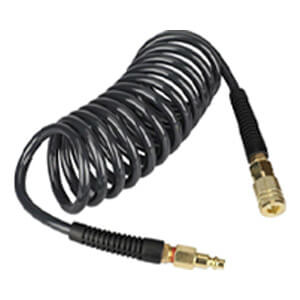An air compressor hoses is a minor element in your system but can be the difference between correct air tool efficiency and reliability. When it comes to industrial, automotive hose or a home DIY hose, the right hose can make a difference.
But with a variety of choices that are available in the market today, how will you know what the best air compressor hoses for you are? This guide covers everything that you need to know about air compressor hoses the various types, materials, sizes, features.
Why Choosing the Right Air Compressor Hose Matters
The benefits of the right air hose for your compressed air distribution system are, in short, better productivity and safety! A hose that’s the wrong size or length can spell disaster in terms of air pressure, efficiency, and wear on your tools. Only a right size hose will ensure right airflow and will be flexible enough to make your work cleaner and more efficient.
If you do use the wrong hose, your air compressor might have to work even harder, and can damage your system. High quality hoses expand productivity, efficiency and to minime down time which is always welcomed; it also adds up more safety to use a good hose, a must for your investment whether you are a professional or just a calssy DIY.
Types of Air Compressor Hoses
Rubber Hoses:
Rubber hoses are very flexible and durable, so they’re a favorite of pros. They stay flexible in extreme temperatures however, they tend to be heavier than other materials.
PVC Hoses:
PVC hoses are light weight and cost effective. But they can be stiff, particularly in cold weather, which could restrict maneuvering.
Hybrid Hoses:
A hybrid hose is a cross between a rubber hose and a PVC hose for the best of both. They are a solid general-purpose pick for most use cases.
Polyurethane Hoses:
Very light and highly abrasion-resistant hoses that are often used for high-movement processes. Of course, they can be pricier.
Essential Tips for Choosing the Right Air Compressor Hose
- Hose length: The hose length dictates your mobility. A longer hose gives you more reach, but it can sap air pressure, and vice versa a shorter hose means more push, but less movement. Pick a length that gives you the flexibility being efficient.
- Hose Diameter: Hose diameter impacts airflow. They come in standard 1/4-inch, 3/8-inch, and 1/2-inch sizes. A wider diameter provides greater air volume, suitable for high-demand tools, but can reduce flexibility.
- Flexibility and Kink Resistance: Flexible hose is easier to work with, especially in tight spaces. They also have kink-resistant hoses that help remove air blockages, and make them more durable and performance.
- Temperature Tolerance: Meant for those working under extreme conditions, look for a hose that can resist both high and low temperatures, so it does not become brittle and lose properties of flexibility.
- Hose Fittings and Connectors: High pressure end fittings for leak proof connection. Brass and stainless steel fittings are strong, corrosion, and rust resistant and therefore most suitable for long-term use.
Top 5 Best Air Compressor Hoses
| 1. WYNNsky Hybrid Air Hose Material: Polyurethane (PU) Nominal Wall: 0.6 month Item Length: 240 Inches Size: 1/4”×20ft Power Source: air-powered Price: Check now |  |
| 2. Goodyear rubber air hose Material: Rubber Inside Diameter: 0.95 Centimeters Maximum Pressure: 250 Pound PSI Item Length: 3.6E+2 Inches Price: Check now |  |
| 3. YOTOO Polyurethane Recoil Air Hose Material: Polyurethane (PU), Brass Item Length: 3.15 Inches Maximum Pressure: 150 Pound PSI Inside Diameter: 0.25 Inches Price: Check now |  |
| 4. FYPower Air Compressor Hose Material: Brass Item Weight: 2.5 Kilograms Item Length: 50 Feet Price: Check now |  |
| 5. Legacy Flexzilla Polyurethane Recoil Air Hose Material: Polyurethane (PU) Product Dimensions: 300″L x 0.25″W Item Length: 25 Feet Price: Check now |  |
Maintenance Tips for Your Air Compressor Hose
- Check for leaks and cracks to avoid loss of pressure regularly.
- Rewind the hose correctly to prevent tangles and kinks.
- After each use make sure to drain any moisture to prevent water damage inside.
- Make sure fittings are clean and lubricated to ensure proper connection.
- In order to extend the life of the hose, do not bend the hose too much.
Conclusion
This guide will send you in the right direction for finding the best air compressor hose depending on the most important factors in regards to flexibility or durability or even cost. Hybrid and rubber hoses are the best overall available option whereas polyurethane or PVC hoses are for specialized needs.
By knowing some of the aspects such as hose lengths, diameters rated pressures and materials; you will be in a position to make wise decision concerning selection of a product that will help improve the performance of your air tool and the ease with which you use your air tool.
How long should air compressor hose be?
It depends on your work area. A hose between 25 and 50 feet in length is ideal for most applications, although longer hoses may be required for larger workspaces.
Can I use any hose for my air compressor?
Air compressor hoses are made for high-pressure air flow, not water. Choosing the wrong type can also cause leaks and inefficiencies.
Do air compressor hoses affect tool performs?
Yes, hose diameter and length affect airflow and pressure, which can make tools more or less efficient.
When should you change your air compressor hose?
Check your hose frequently, replacing it if you see any cracks, leaks or loss of flexibility.


